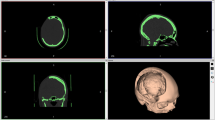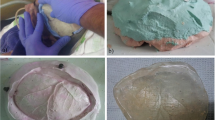Abstract
Background
Cranioplasty aims to reconstruct skull defects from fractures, decompressive craniectomies, tumors, and congenital anomalies in a cosmetically acceptable manner. We present a technique in methyl methacrylate cranioplasty that gives excellent cosmetic results by maintaining patient’s calvarial curvature.
Method
Cranioplasty material is placed into a plastic bag and packed inside the defect. Wire mesh cut larger than the defect is held in position to take the exact skull curvature. Once solid, the implant is fixed in position using titanium plates and mini-screws.
Conclusion
This is a simple, inexpensive method of achieving the most cosmetically desired cranioplasty results.




Similar content being viewed by others
References
Al-Tamimi YZ, Sinha P, Trivedi M, Robson C, Al-Musawi TA, Hossain N, Mumford C, Towns G (2012) Comparison of acrylic and titanium cranioplasty. Br J Neurosurg 26:510–513
Aydin S, Kucukyuruk B, Abuzayed B, Sanus GZ (2011) Cranioplasty: review of materials and techniques. J Neurosci Rural Pract 2:162–167
Blake DP (1994) The use of synthetics in cranioplasty: a clinical review. Mil Med 159:466–469
Chiarini L, Figurelli S, Pollastri G, Torcia E, Ferrari F, Albanese M, Nocini PF (2004) Cranioplasty using acrylic material: a new technical procedure. J Craniomaxillofac Surg 32:5–9
Drosos GI, Babourda E, Magnissalis EA, Giatromanolaki A, Kazakos K, Verettas DA (2012) Mechanical characterization of bone graft substitute ceramic cements. Injury 43:266–271
Gladstone HB, McDermott MW, Cooke DD (1995) Implants for cranioplasty. Otolaryngol Clin N Am 28:381–400
Malis LI (1989) Titanium mesh and acrylic cranioplasty. Neurosurgery 25:351–355
Manson PN, Crawley WA, Hoopes JE (1986) Frontal cranioplasty: risk factors and choice of cranial vault reconstructive material. Plast Reconstr Surg 77:888–904
Marchac D, Greensmith A (2008) Long-term experience with methylmethacrylate cranioplasty in craniofacial surgery. J Plast Reconstr Aesthet Surg 61:744–752, discussion 753
Sanan A, Haines SJ (1997) Repairing holes in the head: a history of cranioplasty. Neurosurgery 40:588–603
Acknowledgments
We thank Kristin Kraus, MSc, and Ramin Eskandari, MD, for editorial assistance with this paper.
Conflicts of interest
None.
Author information
Authors and Affiliations
Corresponding author
Electronic supplementary material
Below is the link to the electronic supplementary material.
Video that demonstrates the cranioplasty technique that yields superior cosmesis through maintenance of the patient’s calvarial curvature. 2 minutes, 50 seconds, 775 MB. (MPG 51614 kb)
Rights and permissions
About this article
Cite this article
Sorour, M., Caton, W.L. & Couldwell, W.T. Technique for methyl methacrylate cranioplasty to optimize cosmetic outcome. Acta Neurochir 156, 207–209 (2014). https://doi.org/10.1007/s00701-013-1800-3
Received:
Accepted:
Published:
Issue Date:
DOI: https://doi.org/10.1007/s00701-013-1800-3




